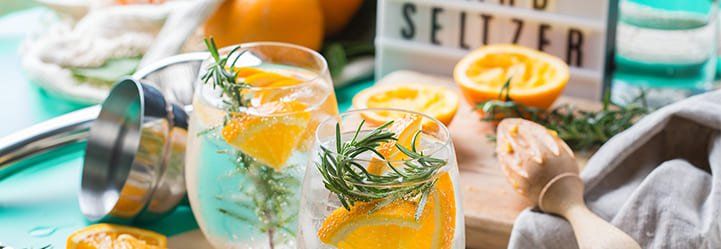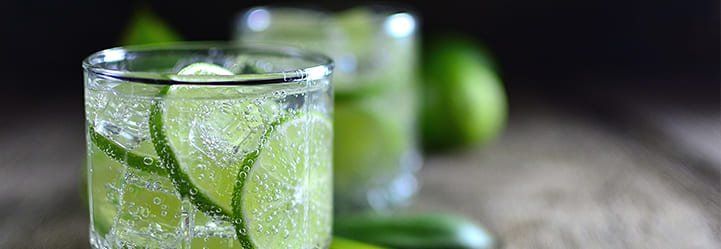Sparkling water vs seltzer: main differences between these drinks
Alimentos SAS • Jul 07, 2021
Americans have been turning away from soda for some time now. As a result, fewer-calorie, bubbly beverages have grown popular during recent years. Keep reading to learn more about sparkling water vs seltzer as the top two contenders in this market category.
The rise of carbonated water
The first step to explore the question of sparkling water vs seltzer is to understand the breakthrough of bubbly water. Once upon a time, Americans considered it a fancy European beverage. Staple brands like Pellegrino and Perrier were rarely available at retail locations during the 1980s and 1990s. To add to this, the United States was not big on drinking bottled water (Nelson & Zarracina, 2016).
Fast forward a couple of years, and bottled water was on the rise. By 2015, the average person in the U.S. drank 37 gallons of it annually. A pointed growth from the four gallons of the late 1980s (Nelson & Zarracina, 2016).
Americans were also drinking less soda in 2015 than a decade before, mostly due to health concerns (Nelson & Zarracina, 2016). Bubbly water took center stage as a leading alternative, as it contains fewer calories, but is still refreshing. To keep up with the boom, long-time players are introducing more flavors, and newcomers are developing their own products (Caballero, 2020).
Its wide distribution also helps. Today, retailers carry multiple brands of carbonated water. The category reached 3.7 billion dollars in sales in 2020 –an 18.7% growth from the previous year (Nelson & Zarracina, 2016).
So, what are the differences between sparkling water vs seltzer?
Sparkling water vs seltzer: how are they different?
Nowadays, consumers come across products branded as either sparkling water or seltzer. How come?
While both are carbonated drinks, they differ in processing methods and added compounds, resulting in distinctive mouthfeel and flavor intensity (Raman, 2020).
Here is the breakdown of sparkling water vs seltzer:
Sparkling water
Also known as sparkling mineral water, it is naturally carbonated due to its diverse mineral content. It comes from springs or wells – as each source is different, so is the taste (Raman, 2020). Adding carbon dioxide is a common practice to pump up natural fizz (Raman, 2020).
Some brands flavor their sparkling water to accommodate consumers’ preferences. Nevertheless, the Food and Drug Administration (FDA) considers it bottled water (Builder, 2018).
Seltzer
On the other hand, seltzer is artificially carbonated. Its bubbles come solely from carbon dioxide, so it is as flavorless as still water (Raman, 2020). Hence, most seltzer is flavored (Warshaw, 2019).
Brands produce tasty options like black cherry and peach-pear using so-called natural flavors. They typically come from essences, but in some instances, they come from authentic fruit juice (Webber, 2019). That is why seltzer might live up to fruit drinks consumers’ flavor expectations.
It also has that refreshing, flavorful feel of its buzzy sibling, the hard seltzer (or even fruited beer), without the alcohol content.
These traits lead to seltzer being labeled by the FDA as a soft drink (Builder, 2018).
Sparkling water vs seltzer and their impact on the industry
Carbonated water seems poised to prosper. Imarc (n.d) projects it will grow moderately between 2021 and 2026 globally as part of the bottled water segment.
Moreover, Research and Markets (2021) estimate the non-alcoholic drinks segment, which includes carbonated water, will achieve a compound annual growth rate of 5.7% by 2026. By that year, consumers looking for alcohol-free, low-sugar beverages will take this segment’s global value to 1.2 trillion dollars.
In fact, the world’s soft drinks and still drinks industries are turning towards low and zero-calorie products (Tetra Pak, 2020). Products in the sparkling water vs seltzer segment are set to thrive if their performance in the American market is to be taken as proof.
Some brands that are joining this trend
Sales of leading brands Sparkling Ice and LaCroix recently grew 27.8% and 18.1%, respectively. Newer independent names, like Waterloo and Spindrift, are also making their mark among consumers. They have increased sales and attracted funding (Caballero, 2020).
Industry giants are taking notes. PepsiCo entered the field in 2018 with Bubly. Coca-Cola followed suit with products AHA and Topo Chico. All these bets are paying off, with healthy sales volumes and year-to-year growth (Caballero, 2020).
When analyzing
sparkling water vs seltzer, factors such as health-driven preferences and retail availability play a central role in their success. Innovation will take this market further, as there are already far more nutritive and flavor options like probiotics, botanicals, and caffeine.















